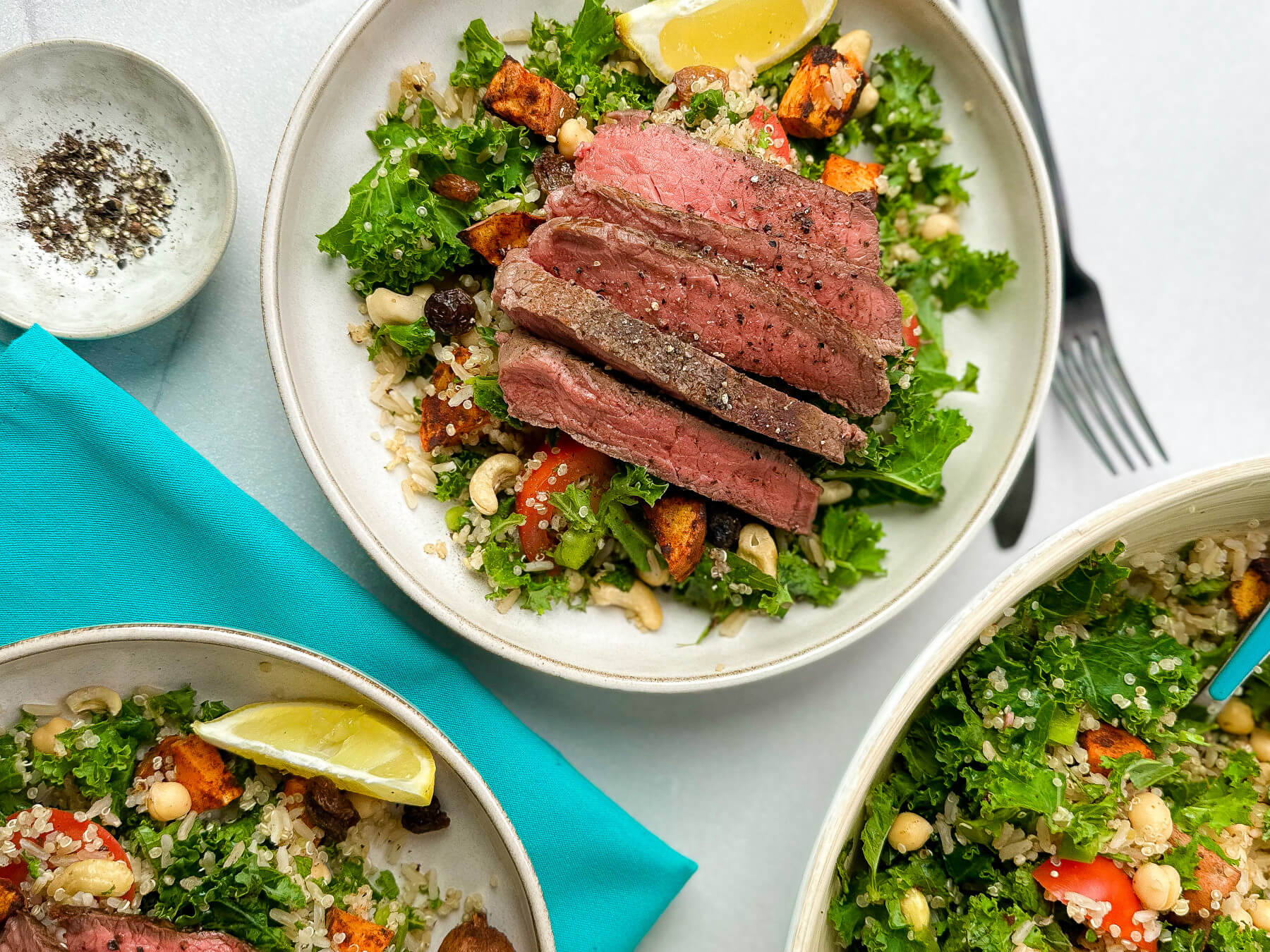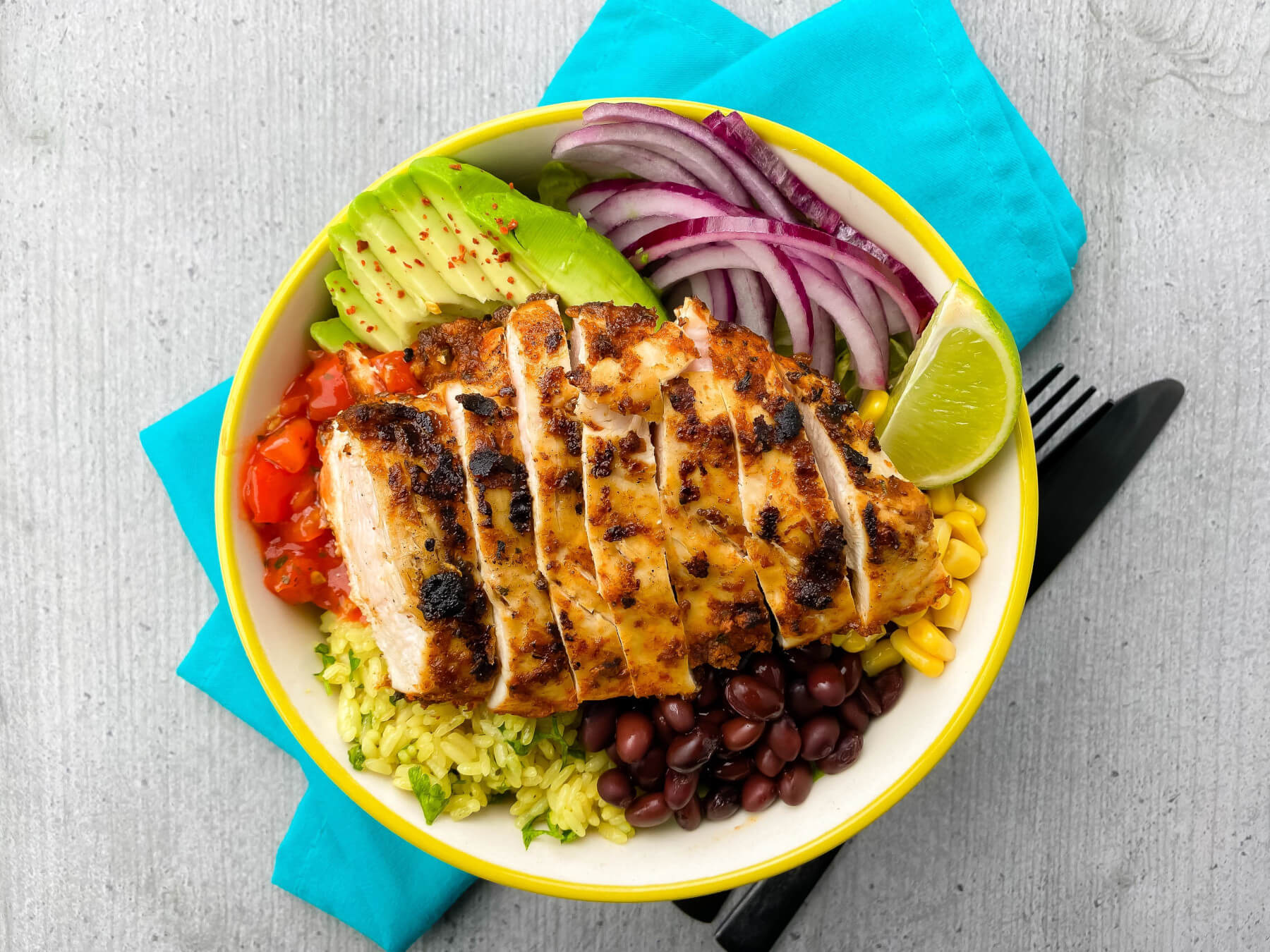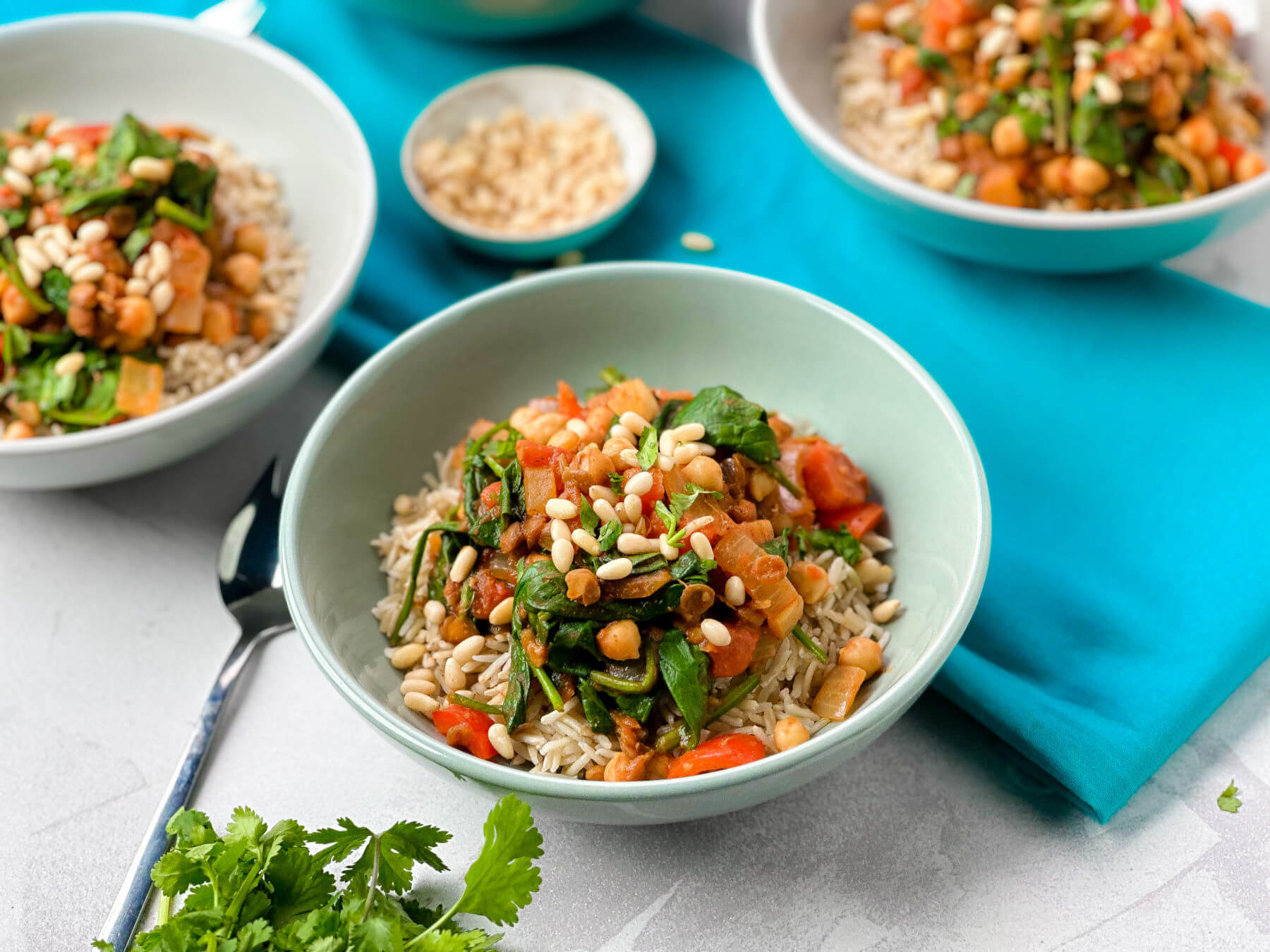The Menstrual Cycle,
Exercise &
Nutrition
How To Make Your Cycle Work For You
The menstrual cycle is something that will affect many of us throughout our lives, with fluctuating hormones impacting everything in our day-to-day, from our mood, to energy levels, to the foods we crave. While the last few years have seen much more openness around the menstrual cycle and menstrual health, it’s something that even in 2023, we feel simply isn’t spoken about enough. Despite so many people having a menstrual cycle, a large percentage are still mystified about their hormones and cycles, even after many years of experiencing periods.
With a huge link between menstrual health, and overall health, there’s a clear need to bring the discussion about menstrual health out into the open - so we’ve taken a deep dive into how the nation’s knowledge of the menstrual cycle currently stands, and how the cycle impacts our exercise and nutrition. We’ve also enlisted a panel of experts to provide medical and fitness-based advice which will help you to make your menstrual cycle work for you.
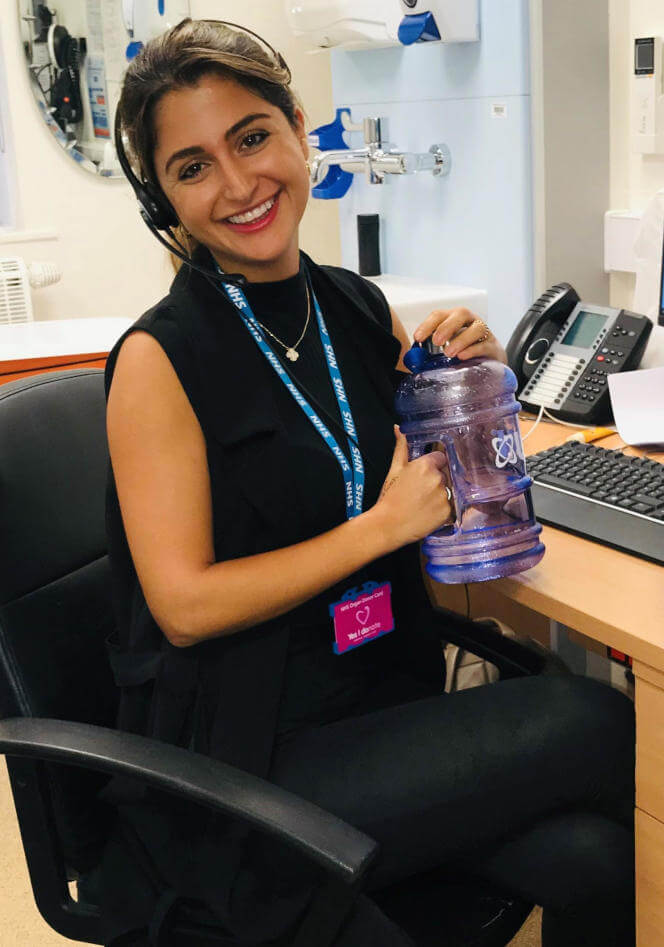
Our research involved surveying more than 2,000 women from across the UK to paint a picture of how menstrual cycles affect us as a nation, as well as highlighting how much we know (or don’t know) about the menstrual cycle. We then worked with Dr Shireen, a GP working in the NHS, who takes a holistic approach to wellbeing and has a particular passion for breaking taboos and raising awareness around women’s health, to get practical and actionable insights and advice to help those who have a menstrual cycle work with their body, not against it.
Dr Shireen sits alongside several of our in-house personal trainers, Emma Ford, Emma Vincent, Jen Buddington, Zoe MacFayden, Hannah Kerridge, Hayley Chapman and Sally Smith, who have shared their professional advice on how to keep active and stay healthy throughout the cycle. We’ve also created a number of recipes and workouts to help you feel your best at every stage of your cycle.
How Much Do We Know About Our Menstrual Cycles?
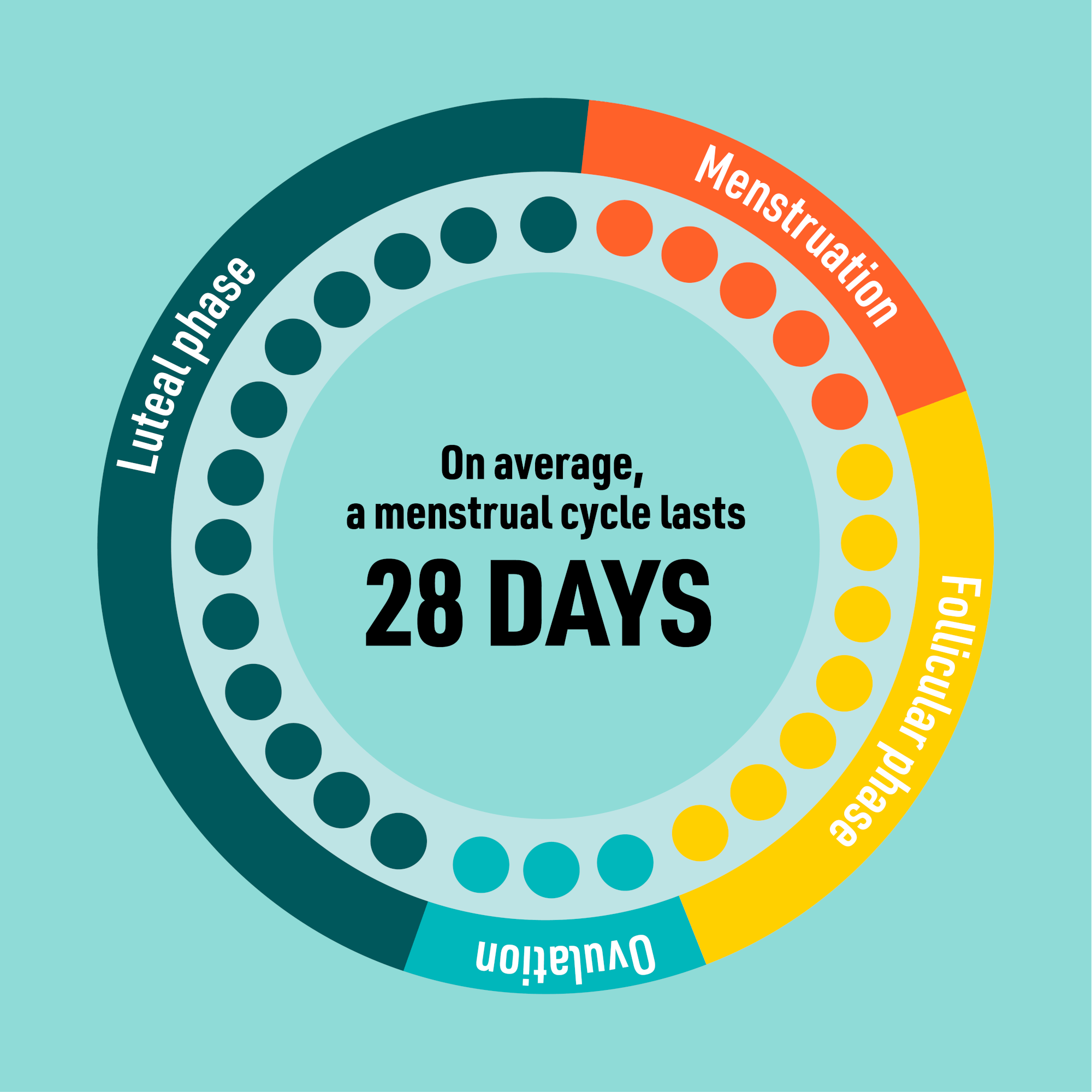
Despite around half the population experiencing menstruation at some point during their life, with the average person starting periods at 12 years old, menstrual health wasn’t made compulsory as part of the national curriculum until 2019. While it is now taught in primary schools; the level of education is inconsistent and often incomplete, with some schools covering this topic in as little as one lesson. It’s no wonder that more than a third (35%) of women say they have no understanding of the menstrual cycle.
The average menstrual cycle lasts for around 28 days, although this can vary between women, and cycles between 21-40 days are also deemed normal. The cycle can be broken down into a number of phases - the menstrual phase (days 1-7), the ovulatory phase (days 4-14), the follicular phase (day 14) and the luteal phase (day 14-28). While these phases are something many of us have experienced from early teens, and may have even been taught in school as part of Science or PSHE, our research found that more than a third (35%) of women have no understanding of either the terminology or the biological processes.
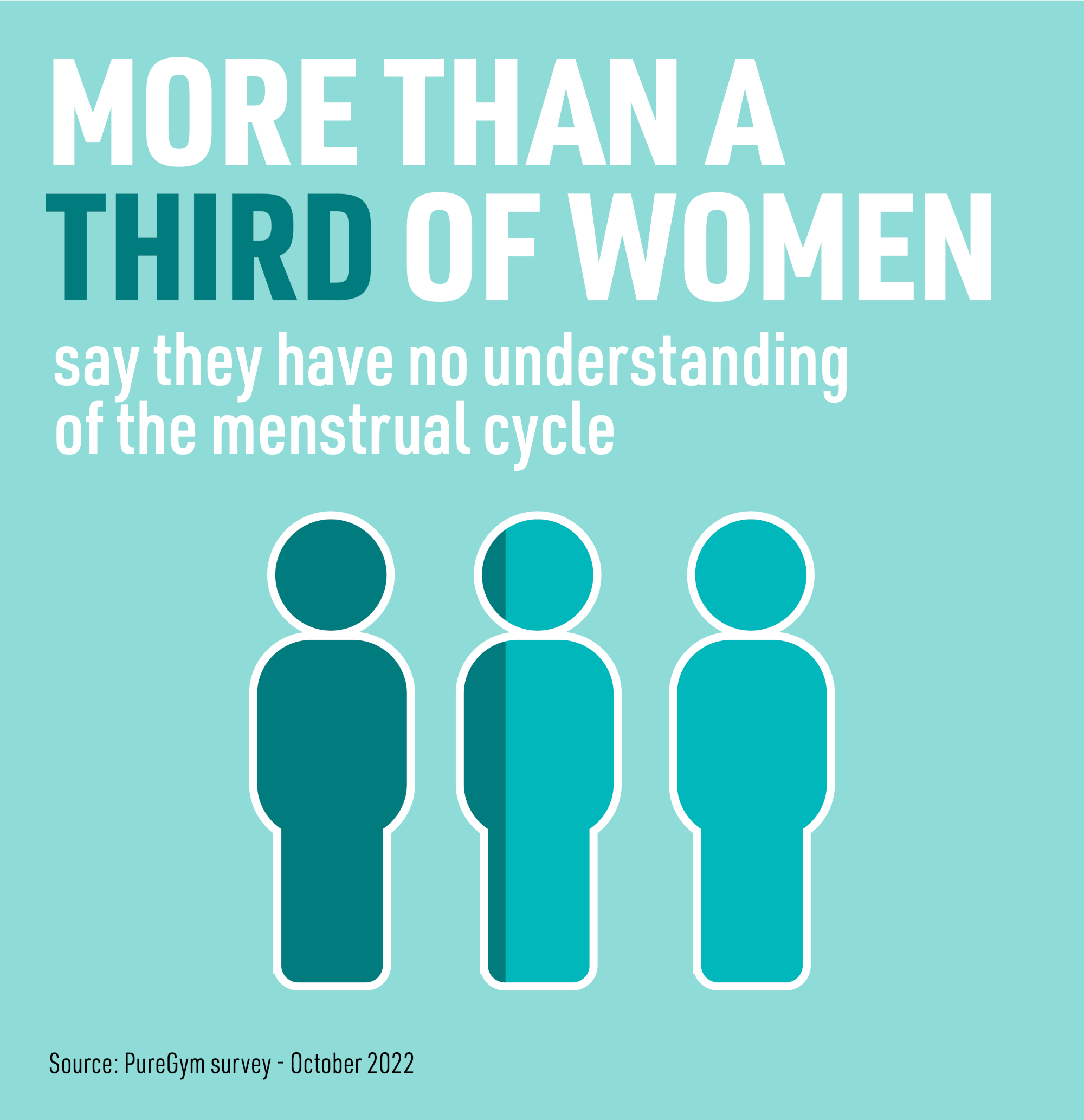
The discussion around the menstrual cycle has increased in recent years, with more women stepping forward to talk about their experiences, be that on social media or through platforms like online news publications. Technology has also helped to further this conversation, with apps, fitness trackers and smart watches developing cycle tracking functions that help women learn more about their menstrual cycle that can even predict their periods and ovulatory phases.
However, this increased discussion hasn’t necessarily led to more understanding. Almost half (47%) of the women we surveyed said that they track their own menstrual cycles using apps or other methods, which makes the previous stat even more shocking - we’re tracking our periods and utilising this tech, but often with very little understanding of its meaning, importance or how it can be used.
Sadly, these statistics aren’t surprising to Dr Shireen: “Women’s health is poorly taught in our schools, and most of the research that exists around exercise is based around men and male physiology. There is a huge gap in general knowledge around hormones, the menstrual cycle and how they impact our wider lives, such as with exercise.”
It’s not all bad news, however. Our research shows that younger generations have more awareness of the menstrual cycle, a sign that increased conversations are making a change. Generation Z are well known for having a passion for mental health, self care, and all-round wellbeing, and it seems the menstrual cycle too. Just 28% of those aged 16-24 say they have no understanding of the cycle, and more than two thirds (68%) of 16-24s said that they track their own cycles, the highest of any age group. Dr Shireen thinks this is likely due to the availability of cycle tracking apps and technologies, but “it may also be generational - the stigmas around menstruation are breaking, and perhaps the younger generations feel more comfortable talking about their periods and tracking them.”
With just 23% of those aged 45-54 tracking their cycles, and 39% having no understanding of the cycle, the generational differences in our knowledge and attitudes towards menstrual health are clear.
You may think the only time it’s worth tracking your cycle is if you are trying to get pregnant, but the reality is we can all benefit from doing this. Our physical and mental wellbeing can be impacted by the changing hormones, and tracking your cycle allows you to better understand why you feel a certain way. Track long enough and you can predict and prepare for symptoms.
In addition to this, Dr Shireen reminds us that tracking can also make it easier for us to know when something changes or may be wrong - particularly for those with menstrual conditions such as PCOS that may cause irregular periods. In older women, tracking your cycle can also help to alert you when you begin to enter the menopause.
What Are the Links Between Exercise and the Menstrual Cycle?
Fluctuating hormones throughout the menstrual cycle play a large part in how we feel day to day, and can impact many areas of our lives, including how we exercise.
If you’ve ever experienced PMS symptoms like fatigue, cramping, and heavy bleeding, you’ll know too well that there can be parts of the menstrual cycle where being active just doesn’t feel possible. But with exercise so important for not only our physical health, in terms of managing our weight, reducing the risk of disease, strengthening our bones and muscles, and countless other things, but also for our mental health, having a limited ability to be active can negatively impact our overall health and wellbeing.
How Does The Menstrual Cycle Impact Our Ability To Exercise?
Varying hormones throughout the cycle can impact everything from our energy levels, to our mood, to how hungry we feel, all which can impact how motivated we feel to exercise, and how much energy we have for activity.
When we asked women who don’t take part in regular exercise - which is defined as a minimum of 30 minutes of exercise, at least 2 days a week - what impact their menstrual cycle had on this, almost a third (32%) said that their menstrual cycle is part of, or the sole reason why they do not exercise. With statistics from the World Health Organisation in 2018 suggesting that almost half of British women are insufficiently active, to see that around a third of these may be inactive as a result of their menstrual cycles is a big shock.
This number increases even more for those who suffer with menstrual disorders, with almost two thirds (65%) of those with endometriosis citing their menstrual cycles as a contributing factor in why they don’t exercise. According to Dr Shireen, endometriosis affects around 1 in 10 women and “can often cause extremely painful and debilitating periods. These women can struggle to get out of bed or go to work - so exercising for many of them is difficult and off the cards.” Those with menorrhagia (heavy periods) and PMS, among other conditions, also have higher levels of inactivity.
Knowing that menstrual health plays a large part in how active someone is, highlights just how important our knowledge of menstrual health is. Dr Shireen emphasises that symptoms and menstrual conditions “can be managed appropriately by a GP or a Gynaecologist and should not be stopping women from exercising.” However, if someone has a disorder but is not aware that the symptoms they experience are abnormal, they may not seek help.
For women who have found themselves avoiding exercise as a result of their menstrual cycle but want to try and get themselves moving again, Emma Ford, a PT from PureGym Bicester has some advice: “Remember that each week will be different depending on the point you’re at in your cycle, so don’t put pressure on yourself to be perfect each week. Start small - with the weight you’re lifting, and the frequency of your workouts - and build it up as you go. Over time, you’ll be able to work out when you lack energy and when and how far you can push yourself.
“Start with 1-2 sessions per week of around 30-45 minutes and build up from there. Gym classes are a great way to try out exercise, so try out a few classes, meet new people and have fun - ultimately you want exercise to be part of your lifestyle and something you enjoy doing.”
Hayley Chapman, a PT at PureGym Barnstaple agrees with this approach, adding: "I would recommend starting at a point in your cycle where you have less intense or no symptoms, and starting with just 10-20 minutes of low intensity exercise once or twice a week. You can slowly increase the duration, frequency, and intensity of the workouts - just make sure to prioritise consistency and frequency over intensity first!"
For Those Who Do Exercise, What Effect Can The Menstrual Cycle Have?
While not all of those who menstruate have symptoms severe enough to prevent them from exercising regularly, the menstrual cycle can still wreak havoc on their training schedules. More than 3 in 5 (62%) said that their menstrual cycle affects their exercise regime, to the point that they have had to stop exercising until symptoms improve, with the average person having their fitness regime affected 3 days at a time.
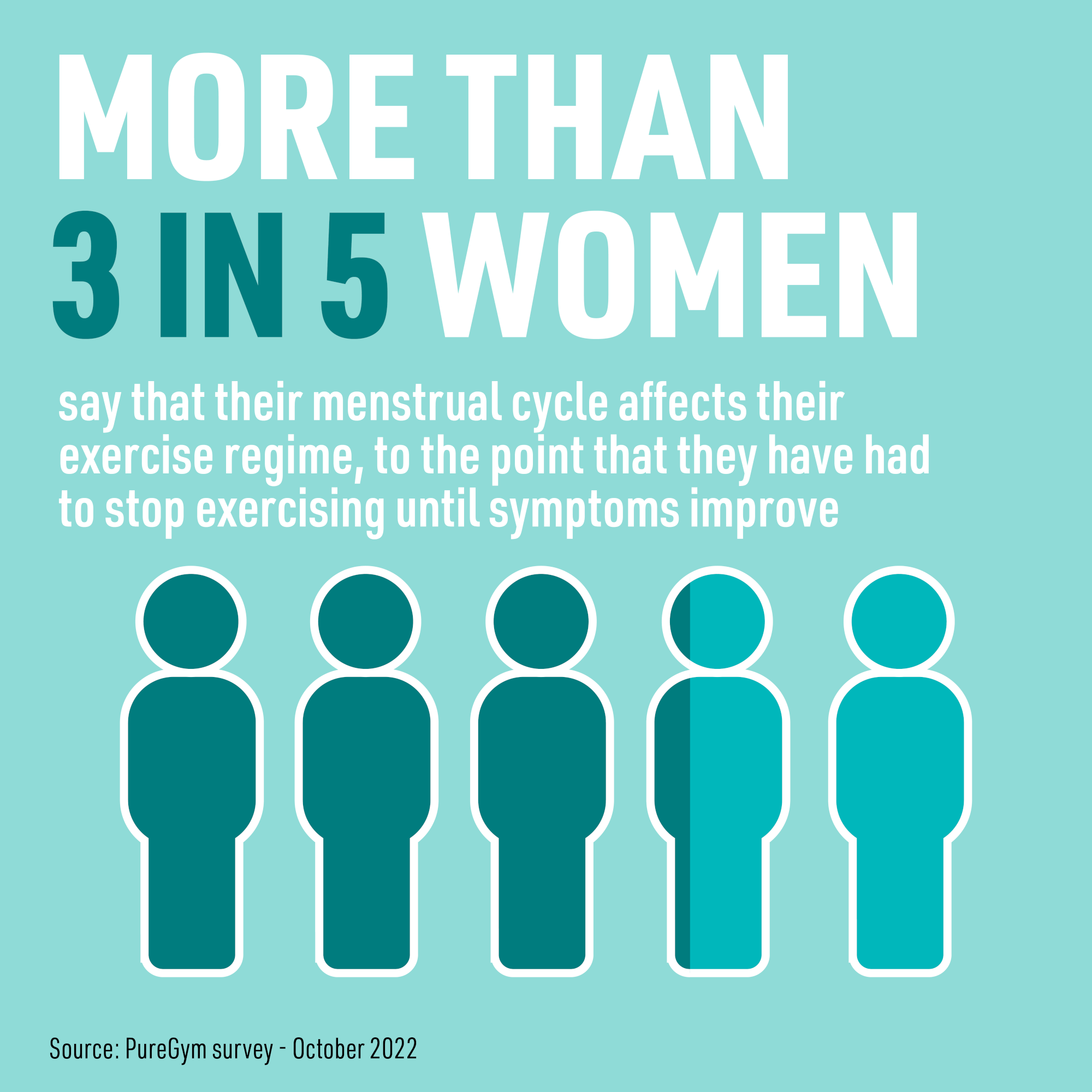
Even if you’re able to exercise throughout the whole menstrual cycle, your performance can still be impacted by the fluctuating hormones; more than three-quarters (76%) of women find it difficult to complete the same workout or achieve the same results at different points of their cycle. This is something that fitness influencer Emma Dransfield knows all about:
“My cycle massively affects how I train in and out of the gym. In the lead up to my period, I see a drop in strength, and some days, PMS can leave me feeling so physically and mentally tired. While this is frustrating, I know it’s due to my cycle and I’m still making progress. I don’t set myself a strict weekly routine as this allows me to listen to my body and train on a day where I have the energy.
“On the other side, I feel stronger than ever towards the end of my period and for 1-2 weeks after. I take advantage of these weeks and really focus on increasing my strength - this is usually the time in my cycle where I try hit some PRs, and I just really enjoy my sessions.
“The main thing I take away from training throughout my cycle is to listen to my body and never beat myself up. One week, I might not be able to lift the same weight I did the week before, and that’s okay! I know my strength will come back again throughout my cycle.”
Emma is not alone; it’s no surprise that some people find they’re unable to exercise to the same level of intensity just before, or during, their period. In the luteal phase (days 14-28), decreased levels of oestrogen and progesterone can lead to symptoms like bloating, fatigue, and low mood, while menstruation can come with symptoms like tiredness and aches, all which can contribute to decreased performance. We talk about this more in-depth a little later.
If you find yourself dreading certain types of workouts at different points in your cycle, it’s important to listen to your body and do the workouts that you feel like doing, rather than forcing exercise you aren’t feeling up to or don’t enjoy. You may even prefer to opt-out of exercise for a few days, although Dr Shireen explains exercise can actually be a tool to manage symptoms: “There is no scientific reason not to exercise while on your period, even if you suffer from a menstrual disorder - in fact, exercise can help relieve many of the symptoms. I would always advise you to listen to your body and opt for lighter cardiovascular/strength workouts during menstruation, and modify your exercise intensity and nutrition at other points of the month if needed.”
In terms of the modifications you can make to your workouts, PT Emma Vincent from PureGym Romford explains that a few simple swaps can make all the difference: “If you’re aching and tired, lower the intensity of your workout. Even your choice of clothing can help too - if you’re bloated, stick to loose, comfortable clothing over tighter gym gear. I’d also suggest the following workout swaps:
- Swap HIIT or running for walking - Walking will still get your endorphins flowing, help to improve symptoms like cramps and bloating, and can be done even if you’re feeling fatigued
- Swap aerobic based classes for yoga or Pilates. These low impact workouts will help with aches, cramps, and low mood, and you can rest or modify exercises when you need a break.
- Swap heavy weights for volume work. Lifting weights can feel tough during PMS and your period. Keep the weights lower and aim for higher reps (if you can) rather than trying to maintain your usual weights.”
Can Exercise Really Help Menstrual Symptoms?
Out of the women we surveyed who do exercise, 7 in 10 (69%) do so to try and manage or relieve PMS symptoms, with low mood (82%), cramps (70%), bloating (65%) and fatigue (62%) the main symptoms women aim to relieve. But does exercise actually help with PMS, or is it an old wives' tail?
According to Dr Shireen, it’s legit: “There is strong evidence to show that gentle exercise, along with other factors such as diet, a reduction in alcohol and stopping smoking, can help to reduce PMS symptoms, with dietary/supplement changes such as reducing caffeine, increasing magnesium, calcium and Vitamin D also helping to alleviate them.”
Several studies have found that exercise helps to reduce premenstrual symptoms like painful cramps and bloating. It is thought that increased circulation, as well as the release of endorphins, is what helps.
Hayley Chapman, explains that light workouts can be a great way to approach exercise during your menstrual phase: "The menstruation phase can generally be approached as a time for rest, either by taking a day off exercise completely, or swapping your weekly high intensity spin class for a ten minute yoga flow or a walk in nature. It's much better to lower the intensity of your workouts for a couple of days up to a week, than push through. The key is listening to your body, so if you feel energised for your regular routine, don't feel you have to dial back."
If you want to workout but find that cramping gets in your way, Dr Shireen suggests taking pain killers, such as NSAIDs (Ibuprofen and Naproxen) rather than paracetamol, as they help to stop the root cause of the pain, rather than masking it.
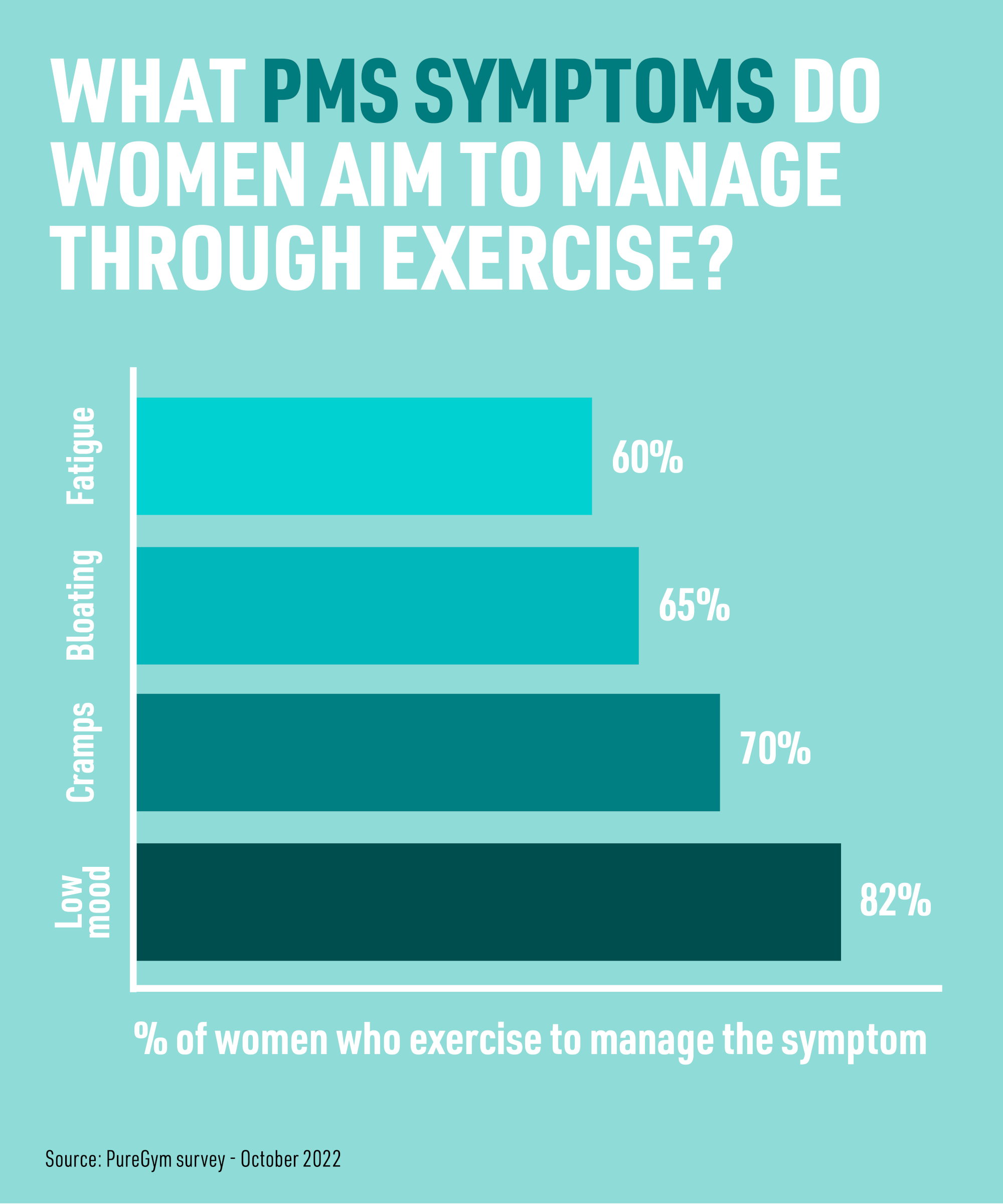
Using the expert insights from Yoga Teacher Jen Buddington, from PureGym Haverhill, we’ve also put together an easy yoga flow to help work through those PMS symptoms specifically. Some studies suggest that yoga can be more beneficial for relieving intense PMS symptoms than aerobic exercise, and it’s easy to do at home in comfy clothes so you don’t even need to leave the house! A quick 5-10 minute session is all it takes to help make a difference to your symptoms.
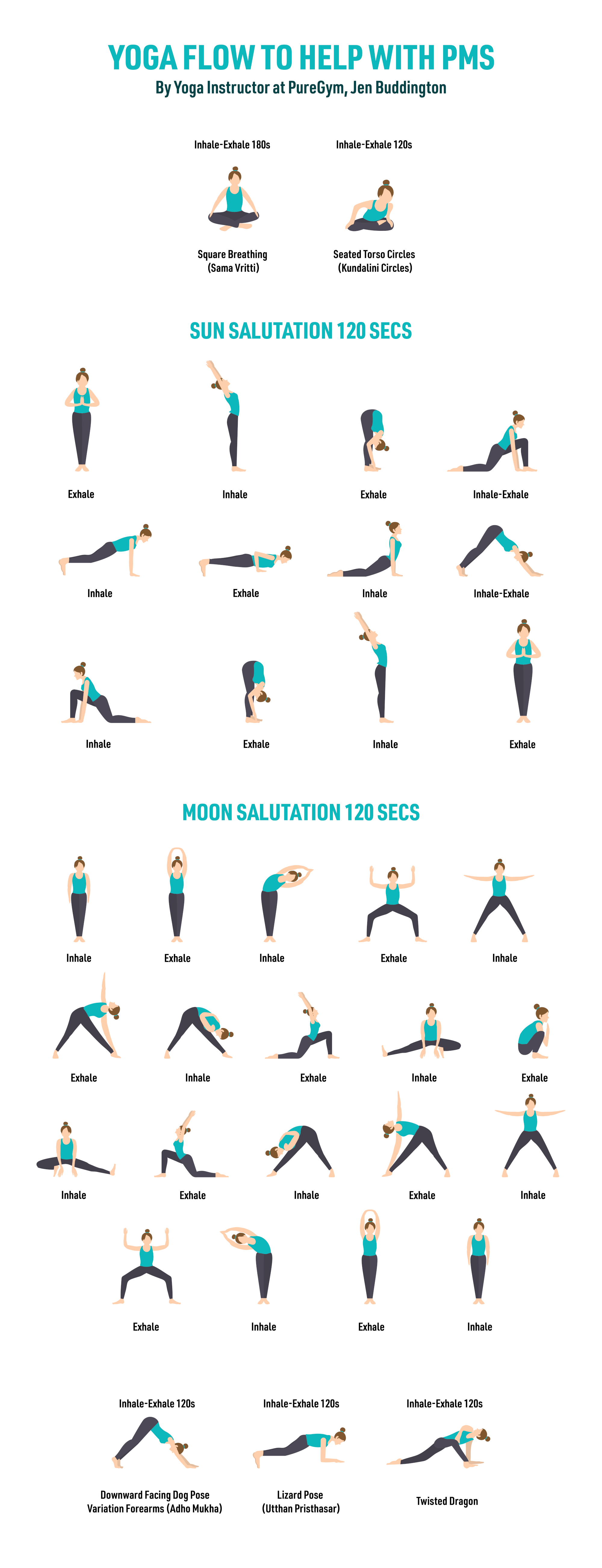
How Can We Adjust Our Workouts To Our Cycles?
The menstrual cycle can also affect performance throughout the month, even for those who don’t experience specific symptoms. Our research showed more than three-quarters (76%) of women find it difficult to complete the same workout or achieve the same results at different points of their cycle. Dr Shireen notes that this can be “a result of hormone changes throughout the month. When oestrogen is low - in the late luteal and early follicular phases - women may find high intensity and high strength training difficult, thus making it difficult for them to complete their workouts/achieve the same results.”
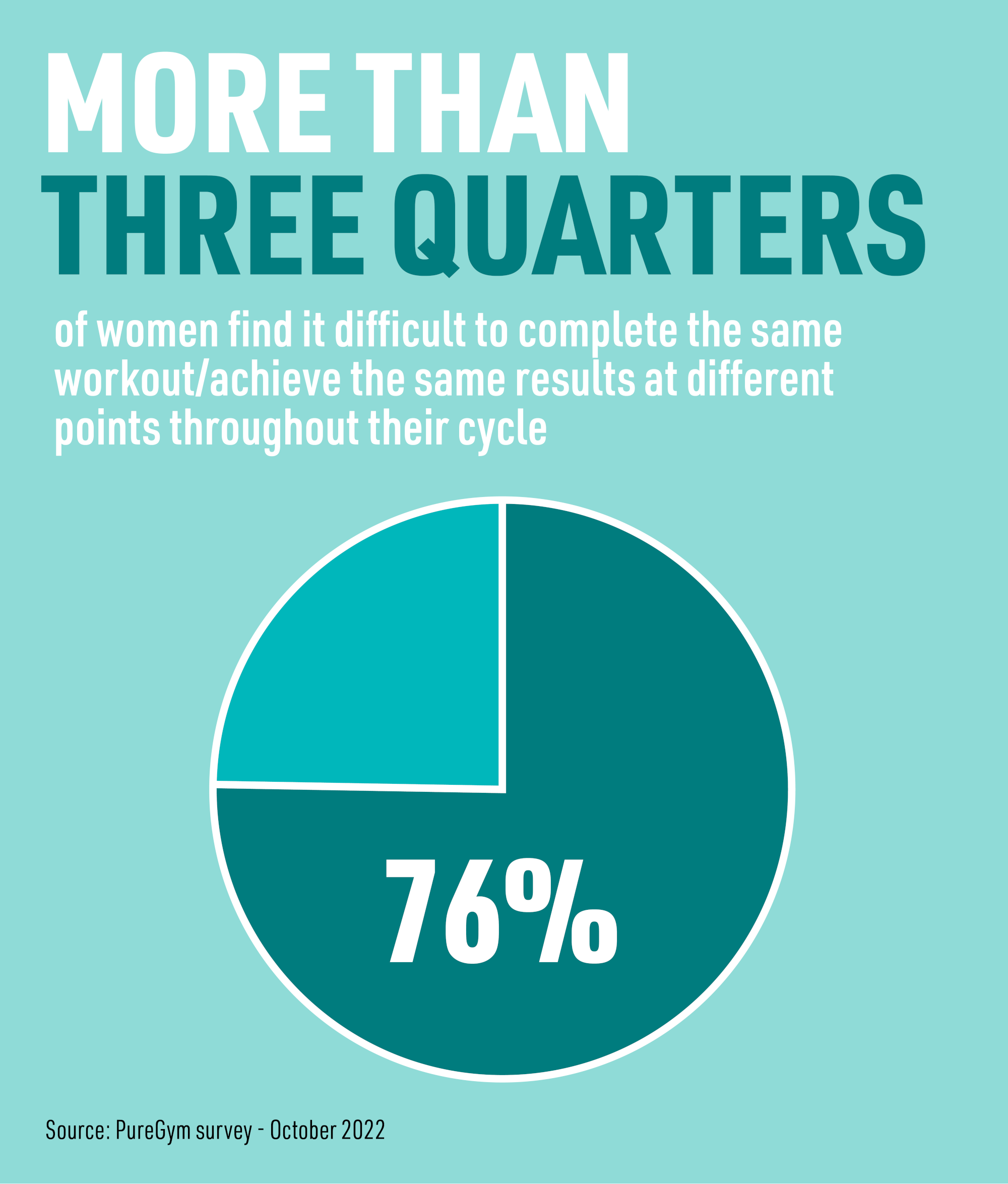
While it’s natural to have differences in performance throughout the cycle, three quarters (72%) of women said that their mental health and feeling of satisfaction from working out has been impacted due to underperformance resulting from lower energy levels or menstrual symptoms, with Crossfit fan Katie Littlewood just one of these women:
“When you consistently train hard and want to hit PBs in your workouts and programming blocks, it’s hard, for example, if your period lands during testing week or on a competition day - it can be really disheartening as you’ve worked for weeks for these moments, only to find yourself not at your best.”
Tracking your menstrual cycle and syncing the type of workout you do to match the phase you’re in can be a way to work with your body, maximise results, and stop negative feelings that arise from being unable to complete certain workouts.
Dr Shireen explains that “people who do [sync their workouts to their cycle] are more likely to feel satisfied after their workouts because they won’t have pushed themselves beyond their limits. They will also have a better understanding as to why their performance may be suboptimal compared to other parts of their cycle, so will be less hard on themselves.”
Of the women we surveyed that do track their menstrual cycles, more than half (54%) said that they also schedule their workouts or adjust their programmes to their cycles, as Dr Shireen has suggested. This is again predominantly done by those within the 16-24 age group (65%), which is likely due to this age group tracking their cycles most frequently and being more aware of how they feel across their cycle.
For those that do adjust their workouts to their cycle, the benefits are clear: those surveyed reported they saw improved mood (43%), managing menstrual symptoms (37%), improved satisfaction from workouts (28%) and heightened performance (15%).
| Impact of tailoring exercise/workouts with cycle | % who feel this benefit |
|---|---|
| Improves mood | 43% |
| Helps manage menstrual symptoms | 37% |
| Improves the feeling of satisfaction after workouts | 28% |
| Heightens performance/helps achieve new records/PBs | 15% |
Feeling Comfortable In The Gym On Your Period
For some, the symptoms of menstruation may not be bad enough to stop exercising, but the thought of exercising on their period can be enough to stop them going.
PT Sally Smith from PureGym Telford has shared her tips on how to make sure you’re feeling your best and make heading to the gym feel that little bit less scary during this phase:
- Plan your outfit - wearing darker colours, longer length tops or even an extra layer (e.g. shorts under leggings) will help you to feel less anxious about potential leaks. If you experience bloating, looser fitting gym clothes are much comfier than tight, high waisted kit.
- Protect yourself - change your period protection just before working out, this way you are better protected from unexpected leaks, and you feel fresh and ready to move!
- Keep on moving - sometimes exercise is the last thing on our mind during this time, but it will improve your mood. No period cramps? Now’s a good time to workout! Oestrogen promotes endurance performance, therefore your body will be performing at its peak. Suffer with cramps? Stick to gentle movement and stretch out to relax.
- Pop the pain relief - try taking some painkillers or similar medication around 30 minutes before you train. This can help to regulate your temperature, dampen any cramps and help you to function a little better.
How Does Our Nutrition Fit Into This?
If you thought craving chocolate before your period was just an overdone cliché, you’d be wrong. Changes in hormones can affect both how hungry you are, and what you are hungry for. While this can look different for different people, there’s no shame if you find your appetite being strange at certain points in your cycle.
More than half (53%) of those surveyed said that they felt hungrier and/or thirstier during certain phases of their cycle, and 38% said that they crave different foods and/or levels of fluid during each phase. As a result, a whopping 9 in 10 (90%) women said that they ultimately find it hard to maintain a healthy diet throughout their full cycle. While this is a shocking number of people, it makes sense - if the amount and type of food you crave varies each week, it’s hard to plan and stay on track.
According to Dr Shireen, all of these feelings surrounding nutrition are completely normal, as a result of hormone fluctuations causing changes to our basal (resting) metabolic rate, and therefore the calories we burn - in the second half of the cycle, this can translate to burning an extra 300 calories a day!
This highlights how important it is to listen to your body - if you’re feeling extra hungry in the run up to your period, it may be because you’re undereating. This also explains why many people crave fatty, sugary foods like chocolate - these calorie dense foods are a quick way for your body to get the energy it needs, however eating fibre rich carbohydrates such as sweet potato and butternut squash can help curb these cravings. It’s also best to avoid going ‘low carb’ at this point before your period too as a result.
Another reason cravings for sugary and fatty foods can occur before your period is that these foods release serotonin, a hormone which improves mood. If your PMS is accompanied by a side of low mood, you may find yourself reaching for these foods to improve mood.
People who menstruate also need to make sure they are eating enough iron in their diet, particularly before and during their period. Women who have a monthly cycle have a higher iron requirement than men of the same age, and not getting enough iron can make PMS symptoms worse.
Nutritionist Sarah Jackson comments on this, saying: “There are two main sources of dietary iron; haem iron which is found in animal-based food and non-haem iron which is found in plant-based foods. Haem iron is the most bioavailable form of iron, with red meat being a rich source of this. However, non-haem iron is the predominant source in our diets and is in foods such as cereals, pulses, beans, nuts, fruit and vegetables. Non-haem iron absorption can be affected by different foods, for example calcium reduces the absorption, while vitamin C increases the absorption. A great way to increase the iron you get is pairing beans and pulses with veg rich in vitamin C like tomatoes. You can also sprinkle seeds on your salads, add beans to your dishes, and eat small amounts of dried fruit."
Our expert PT, Zoe MacFayden from PureGym Cambridge has shared her top tips for keeping on track for your wider nutrition goals throughout the month, even if you find yourself struggling to maintain a healthy diet:
- Use a flexible dieting approach to plan in things you know you crave - If you track your food, a good way to approach cravings is to include the foods you crave into your diet. Using a flexible approach like calorie counting or macro counting allows you to add in the food you’re craving and still hit your daily targets to support your goals. You can either add in the food you think you’re going to crave to your food tracker at the start of the day and work around it or save 100-200 calories a day as “free calories” to use on what you’re craving. If you don’t track your food or aren’t dieting, make sure to include moderate amounts of the food you are craving - this will help to prevent binging on these foods!
- Look to increase your “feel good” neurotransmitters through other methods - We know that serotonin is lower during your luteal phase which can cause cravings, so a good way of managing this is to find that mood boost elsewhere. Exercise, sunlight, and socialising with loved ones have all been reported to help boost mood.
- Remember this feeling will pass! - Sometimes it feels like these cravings are overwhelming, but the change in hormones is temporary and after about day 3-5 of menstruation your PMS symptoms and cravings should ease. Knowing your body and when to expect these feelings can be helpful in managing them. Why not try tracking your cycle so you know when to expect cravings, and when they should go.
- Take a diet break during this week - If you’re really struggling with your diet during this phase of your cycle, it might be a good idea to take a diet break each month for it. This involves bringing your calories up to maintenance level for a short time and then reducing them back down once you feel able (normally about day 3-5 of your bleed). During this phase of your cycle, many people’s metabolism is slightly higher, which is one of the reasons why you feel so hungry. Bringing your calories up helps to account for this, and as long as you stay around maintenance level, it won’t impact your progress in the long term. In fact, allowing more flexibility to enjoy some of the food you’re craving without feeling like you’ve “blown” your diet can actually be more beneficial than restricting and binging.
Working With Your Cycle - Syncing Up Your Workouts and Nutrition

Phase 1 - The Menstrual Phase (Days 1-7)
The menstrual phase (or period) of the cycle occurs from day 1, until around day 7 for most people, although this can vary. This is often a time of the month when many women may find exercise more difficult, as a result of their bleeding and associated symptoms such as cramps.
For women who said that they track their menstrual cycles and tailor their workouts accordingly, walking ranked as the most popular form of exercise during this phase, with almost half (49%) using it as a key form of exercise. Other lighter forms of workouts such as yoga (26%), dancing (16%) and Pilates (14%) also proved popular.
Which Forms Of Exercise Do Women Favour During The Menstrual Phase?
| Rank | Activity | % of women who do this form of exercise |
|---|---|---|
| 1 | Walking | 49% |
| 2 | Yoga | 26% |
| 3 | Running | 21% |
| 4 | Dancing | 16% |
| 5 | Pilates | 14% |
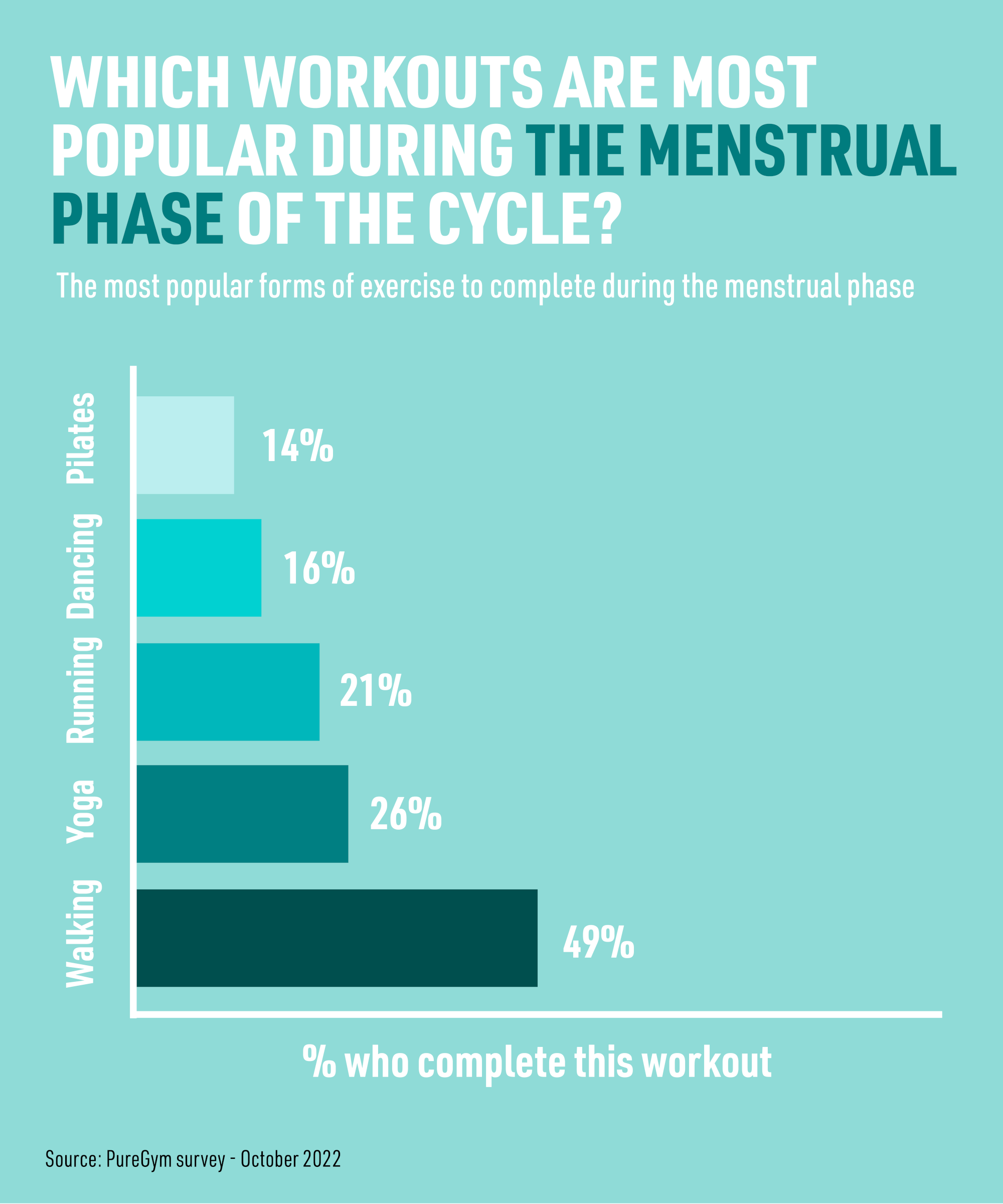
According to Dr Shireen, our levels of oestrogen and progesterone dip during menstruation, causing our strength and endurance performance to also see a similar dip. As a result, you may be more inclined to do low-moderate intensity exercises such as yoga, Pilates, and walking during this time. However, if you do feel okay to power through a high energy workout, you can absolutely do so!
Phase 2 - The Follicular Phase (Days 4 - 14)
The follicular phase overlaps with menstruation, starting on day 1 of your cycle and ending in ovulation - this typically lasts around 14 days. During the first half of this phase, including menstruation, oestrogen is low which can lead to symptoms such as cramps, low energy, and slower recovery. You may continue to benefit from lower intensity and more recovery-focused exercises during this time.
However, during the later stages of the follicular phase (days 10-14), oestrogen levels surge, and progesterone levels are low. High oestrogen levels create a boost in energy. It can also promote muscle building and enhance recovery, meaning this is the optimal time to be doing strength training in the gym. Whether your goal is hypertrophy or strength, use this natural increase in energy and recovery to beat some PBs and smash some goals.
PureGym Colchester based PT Hannah Kerridge says: "The first two weeks of your cycle can be where some of your best training sessions happen, and research shows we recover from workouts faster here too! Use this time to get the most out of strength and muscle growth by incoporating compound exercises like squats, bench, and deadlifts, get those personal bests, and progressively overload your lifts."
Looking at the exercises that are most popular during this phase, the picture is mixed as a result of these hormone changes - although walking remains most popular (38%), followed by running (17%) and yoga (16%), weight training also ranks among the top 5 workouts for this time.
Which Forms Of Exercise Do Women Favour During The Follicular Phase?
| Rank | Activity | % of women who do this form of exercise |
|---|---|---|
| 1 | Walking | 38% |
| 2 | Running | 17% |
| 3 | Yoga | 16% |
| 4 | Weight training | 13% |
| 5 | Legs, bums & tums | 13% |
In terms of nutrition, it seems that this is something that mystifies many, with more than half (55%) of women saying they don’t know which foods they should be eating during the follicular phase. To help combat our confusion, Dr Shireen has shared her top tips for nutrition: “During this phase it is important to stay hydrated and to eat nutrient rich foods, to keep energy and blood sugar levels steady. A good mix of lean protein, healthy fats and whole grains can all help to support our biological processes.”
Phase 3 - The Ovulatory Phase (Day 14)
Ovulation occurs mid cycle around day 14, when a mature egg is released from the ovaries. As with the late follicular phase, oestrogen is high at this point, so women generally feel more energised and able to do higher intensity exercises - this is a great time to try HIIT training, or attempt some PBs in the gym.
The popular workouts at this point are largely similar to those seen in the follicular phase, although the popularity of higher energy workouts such as running (18%) and legs, bums and tums (14%) have increased in comparison.
Which Forms Of Exercise Do Women Favour During The Ovulatory Phase?
| Rank | Activity | % of women who do this form of exercise |
|---|---|---|
| 1 | Walking | 32% |
| 2 | Running | 18% |
| 3 | Yoga | 16% |
| 5 | Legs, bums & tums | 14% |
| 4 | Dancing | 12% |
Phase 4 - The Luteal Phase (Days 14 - 28)
The luteal phase is the final phase in the menstrual cycle, and sees both progesterone and oestrogen levels increase, and the lining of the uterus to thicken in preparation for potential pregnancy. During this time, increased progesterone can cause bloating and fluid retention, symptoms which can prevent women from reaching their full potential with exercise due to discomfort. Body temperature also increases, which can make high intensity exercise feel more uncomfortable as a result.
As oestrogen levels remain high into the mid-luteal phase, the opportunity for women to push themselves with higher intensity workouts continues. However, towards the end of this phase as oestrogen drops, many will experience PMS symptoms and a decline in energy. Switching to lower intensity workouts can be beneficial here.
According to our research, yoga (18%) and Pilates (13%) are the two forms of exercise that prove to be much more popular in this phase than others, which matches up with the lower intensity exercise that best suits the later stages of the luteal phase. However, running (15%) and legs, bums and tums (12%) workouts also remain staples for the earlier parts of the phase - a sign that, as always, everyone is different, and some may prefer not to change their workouts throughout their cycle. If you do prefer to keep the type of workout consistent but find your energy drops at certain points, you can lower the intensity of the workout itself by dropping the pace, adding in more rests, decreasing the workout length, or swapping to lower intensity variations.
Hannah Kerridge says: "If you find during this phase that workouts feel tougher, just scale the workout down and listen to your body. You may want to reduce intensity slightly which can be by swapping compound movements out for machine work, focusing on lower weights with more volume work, or going for walks rather than runs. Research has shown that continuing to exercise during your period helps to ease symptoms so I would suggest always to keep your body moving if you can!"
Which Forms Of Exercise Do Women Favour During The Luteal Phase?
| Rank | Activity | % of women who do this form of exercise |
|---|---|---|
| 1 | Walking | 32% |
| 3 | Yoga | 18% |
| 2 | Running | 16% |
| 4 | Pilates | 13% |
| 5 | Legs, bums & tums | 12% |
While the preferred exercise for each phase differs, it’s clear that there is still a lack of knowledge surrounding each phase. Over half (56%) of women admit they have no understanding of how the luteal phase impacts core body temperature, resting heart rate, and breathing rate.
Additionally, another 3 in 5 (62%) said that they have no understanding of the foods they should be eating during the luteal phase. As this is the point of the cycle where women may experience PMS and begin to have cravings in the run up to their period, understanding nutrition requirements for the luteal phase will help women to understand why their appetites can feel so different here.
Dr Shireen explains: “As the progesterone levels increase during the luteal phase, so does the appetite and cravings. There is also an increase in the resting metabolic rate during this time, so in terms of keeping an ‘energy balance’ there is an increase in needs - this is why women often crave high fat and carbohydrate-based foods at this point.
“The hormonal changes that occur during the luteal phase can increase cravings for high fat and high carbohydrate-based foods. Incorporating fibre rich carbohydrates such as sweet potato and butternut squash in the week before your period can help curb the cravings for processed carbohydrates like ice cream and chocolate! It’s definitely best to avoid going ‘low carb’ before your period too.
“If you’re someone that finds yourself suffering from PMS, foods rich in magnesium such as tofu, dark greens, eggs, lentils and chickpeas can really help.”
Does Hormonal Contraception Have an Impact?
Hormonal contraception is often prescribed as a ‘solution’ to many menstrual symptoms - including particularly painful or heavy periods. But how does it impact our cycles and our relationship with exercise and nutrition as a result?
Of the women surveyed who noted that they currently take hormonal contraception, 1 in 10 (11%) said that they found exercising easier without it. However, 14% of those who have previously taken hormonal contraception, but no longer do, said that they found exercising easier while on contraception.[1]
This didn’t make things a lot clearer, so we asked Dr Shireen for her expert opinion on the matter:
“Most of the research has shown that there’s no significant change in strength or high intensity exercise between women who take the pill and those who do not.
“Many women take the pill to help alleviate period pain (particularly if they suffer from conditions such as endometriosis). The pill can also help to regulate periods which is great for women who suffer from irregular cycles, such as those with PCOS. Many women use contraceptives as a long-term solution, particularly in cases such as these where there is no ‘cure’ for their menstrual condition, so we ultimately want to manage their symptoms.”
So, if you’re someone that feels like the symptoms associated with menstruation and your menstrual cycle are having a big impact on your life, contraceptives could be a potential route forwards, particularly when it comes to establishing a healthy routine and relationship with exercise. And you can be rest assured that outside of relieving symptoms, they shouldn’t impact your workout performance.
Conclusion: Making Your Cycle Work For You
It is clear from our research that there is a lack of knowledge around menstrual health and the impact the cycle has on exercise and nutrition. Few women have knowledge on the phases of the cycle, the associated hormonal changes, and the impact they can have on energy levels, appetite and metabolism, and education on this topic can give women a better understanding of why they might struggle with exercise and nutrition at certain stages each month.
Using cycle tracking to know what phase of the menstrual cycle you are in can help you to work with your body rather than against it, for example by modifying your workouts, switching up your nutrition, or simply being kinder and more understanding to yourself! However, not everyone will see the same benefits from doing so, as everyone is affected by these hormonal changes differently. Those who experience pronounced symptoms and changes through the cycle will likely find this more beneficial than those who don’t notice big fluctuations. Regardless, tracking is a helpful tool to listen to and work with your body, and can help to alert to any issues early on.
The research also highlighted that there are large numbers of women that avoid exercise when menstruating or during their menstrual cycle, as a result of their symptoms. As Dr Shireen has reminded us, symptoms that are so severe they interfere with daily activities like exercise are not normal and can be improved: “I would urge these women to see their GP, and to get control of their symptoms so that these in particular aren’t a limiting factor when it comes to their exercise routine.”
How To Prep For An Appointment With Your GP
If you struggle with extreme symptoms associated with your menstrual cycle, a visit to the GP should be the first point of call. Dr Shireen has shared her top tips for your GP appointment, to help make the most of it, and ensure you end up on the right course to treatment:
- Make a list of the main symptoms troubling you, and how they impact your life - for example, are your periods heavy, painful, or irregular? Are there any other symptoms that are bothering you outside of your period, such as irregular spotting? It’s easy to be overwhelmed or nervous during consultations, so write down your points on paper or in the notes on your phone to help you remember!
- Discuss your expectations with your GP - some women want a diagnosis, but don’t mind about the symptoms, while others just want their symptoms to go away, but don’t care about the diagnosis. Similarly, some will be happy to be treated by their GP, while others want to go straight to a specialist. If you can explain what you want to happen to the GP, it can make setting up a plan of action much easier.
- Take any resources with you - if you’re someone that’s done some research before your appointment, take these articles or websites with you to discuss. In the case of periods, if you’re someone that uses tracking, take the app or data along with you, as it can be very helpful for GPs to review.
Finding A Personal Trainer
If you’ve found the workouts, recipes and tips compiled by our team of PT’s, and feel you could benefit from more regular advice from a fitness pro, you can learn more about getting a personal trainer here . Alternatively, you can find more workouts that can be applied to each phase of your cycle in our free workouts and exercises sections!
Methodology
PureGym partnered with Censuswide to survey 2,025 women who have a menstrual cycle/period - 50% of whom take part in at least 30 minutes of exercise, two days per week, and at least 500 of whom do not currently take any form of hormonal contraception.
Dr Shireen, and our panel of PureGym PTs provided expert insight on the results of the survey, and helped to craft the survey, as well as suggested workouts/recipes.
1Full survey question reads - “Q8. You previously noted that you are currently taking or have taken hormonal contraception in the past. Have you found that exercising during your cycle is easier or harder to manage in either scenario? For example, you find that it is/was easier to train consistently throughout the month when on contraception that managed your hormones, or vice versa”
*Those who are currently taking or have taken hormonal contraception in the past
- The 11% represents respondents currently on hormonal contraception who selected the combined ‘harder’ options
- The 14% represents respondents who have previously taken hormonal contraception, but no longer do, who selected the combined ‘harder’ options
Fancy tailoring your workout session further? Arrange a session with your local gym or check out our popular gyms in London, Manchester gyms or our best gyms in Edinburgh. For even more inspiration, head over to our exercise guides and free workout videos.

This work is licensed under a
Creative Commons Attribution-ShareAlike 3.0 Unported License
